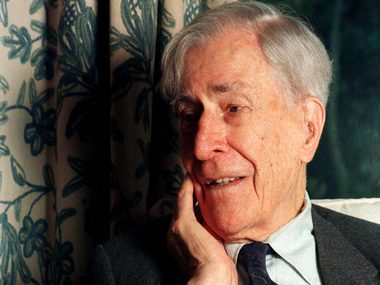By Thomas Laubach and Ajay Shah.
Economics is a rich and fascinating subject. But all too often, the teaching process forces young people in the field to look at the tail of the elephant, to think about macroeconomics as the game of solving dynamic models. There is actually much more going on. (On a related note, you might like to see Books that should be read before starting a Ph.D. in economics on this blog, 18 May 2011).
In this blog post, we walk through the evolution of the key ideas in historical order, and offer suggestions to interesting readings, which will help you see the fuller picture. Many of them are on your reading list, but some are not.
The old paradigm
Nobody tells it better than The age of uncertainty by John Kenneth Galbraith.
The old paradigm is now in the dustbin of history. But in order to comprehend the revolution in macroeconomics, it is rather useful to start from there. One encounters these arguments from time to time, so it’s worth knowing about the furniture of that mind.
The revolution of modern macroeconomics
The starting point is a speech : The role of monetary policy by Milton Friedman, American Economic Review, 1968, which had enormous influence in arguing that the mainstream Keynesian paradigm was fatally flawed, and that it was not going to work as a guide to policy on a sustained basis. By the early 1970s, the empirical evidence was showing that Friedman was on the right track, which led to everything that followed. This speech is arguably the beginning of modern macroeconomics. At the same time, this was only an argument conducted in English, and not a model.
The next big milestone was the Lucas critique: Econometric policy evaluation: A critique by Robert Lucas, Carnegie-Rochester Conference Series on Public Policy, 1976. This devastated traditional macroeconomics. In addition, it’s a remarkably elegant idea.
[caption id=“attachment_208860” align=“alignright” width=“380” caption=“Harvard University professor and economist John Kenneth Galbraith. Reuters”]  [/caption]
Lucas, Sargent and others mapped out a work program in a series of non-technical pieces, which were enormously influential. They set a generation of economists going to build a class of models that were rooted in the intuition of Friedman, 1968, and were invulnerable to the Lucas critique. You should read: Understanding business cycles by Robert Lucas, Carnegie-Rochester Conference Series on Public Policy, 1977; After Keynesian Macroeconomics by Lucas and Sargent, Federal Reserve Bank of Minneapolis Quarterly Review, 1978; Methods and problems in business cycle theory by Robert Lucas, Journal of Money, Credit and Banking, 1980.
As important as the Lucas Critique was Rules rather than discretion: The inconsistency of optimal plans by Kydland and Prescott. An accessible set of materials on this work is found in their 2004 Nobel Prize page.
This work came to fruition in the early 1990s in the form of the NK-DSGE model with a policy rule. Important tools got developed in a classical setting (the RBC model), and then Keynesian frictions were put in, to give the NK-DSGE model. It has many problems, but with this, the Lucas program did work out. Nice readings on the NK-DSGE model are The science of monetary policy: A new Keynesian perspective in the JEL by Clarida, Gali, Gertler (1999), and their Monetary policy rules and macroeconomic stability: Evidence and some theory in the QJE in 2000.
The new macroeconomics is nicely showcased in Technology, employment, and the business cycle: Do technology shocks explain aggregate fluctuations? by Jordi Gali in AER, 1999. This is a wonderful example of confronting empirics with theory, plus a fundamental (if highly controversial) contribution in the eternal quest for the sources of business fluctuations.
On the other side, there is a powerful critique of the micro-founded approach to macroeconomics: The scientific illusion of empirical macroeconomics by Larry Summers, Scandinavian Journal of Economics, 1992.
By the late 1990s, there was a lot of progress to report. There is a nice article: Thirty-Five Years of Model Building for Monetary Policy Evaluation: Breakthroughs, Dark Ages, and a Renaissance by John B. Taylor, Journal of Money, Credit and Banking, 2007. There is the best single book on monetary policy: Monetary Policy Strategy by Frederic S. Mishkin, 2007. And, there are two other nice articles: A stable international monetary system emerges: Inflation targeting is Bretton Woods, reversed by Andrew K. Rose, Journal of International Money and Finance, 2007, and How the World Achieved Consensus on Monetary Policy, by Marvin Goodfriend, Journal of Economic Perspectives, 2007.
The second stage
Once the basic plan was laid, important work emerged in connected fields. A critical issue that came to fore was the role of finance in macroeconomics. Agency costs, net worth, and business fluctuations by Bernanke and Gertler, AER 1989, is the most elegant illustration that financial structure matters for macroeconomics.
We close this off with a canonical reference about fiscal policy from a macro perspective. A good recent treatemnt is Activist fiscal policy to stabilise economic activity by Auerbach and Gale, from the 2009 Jackson Hole symposium.
Post-crisis revisionism?
On this, see Monetary policy and financial stability: Is inflation targeting passe? by Takatoshi Ito, July 2010.
Ajay Shah’s Blog

)
)
)
)
)
)
)
)
)



